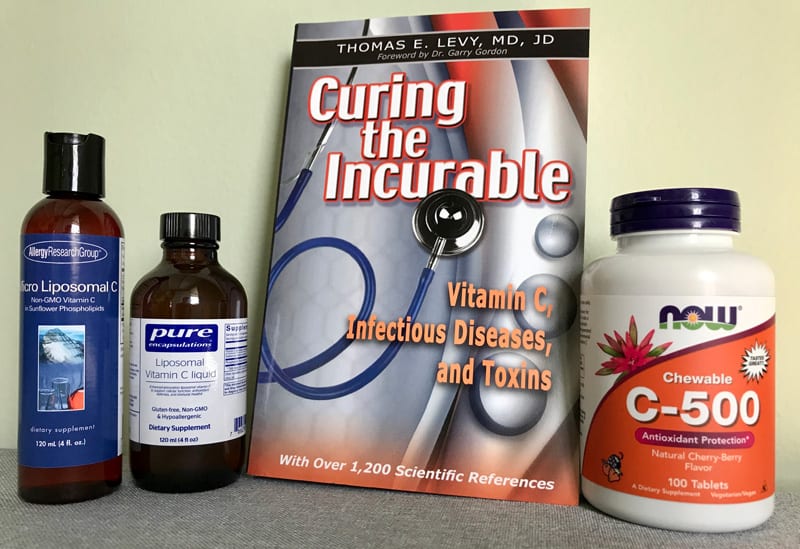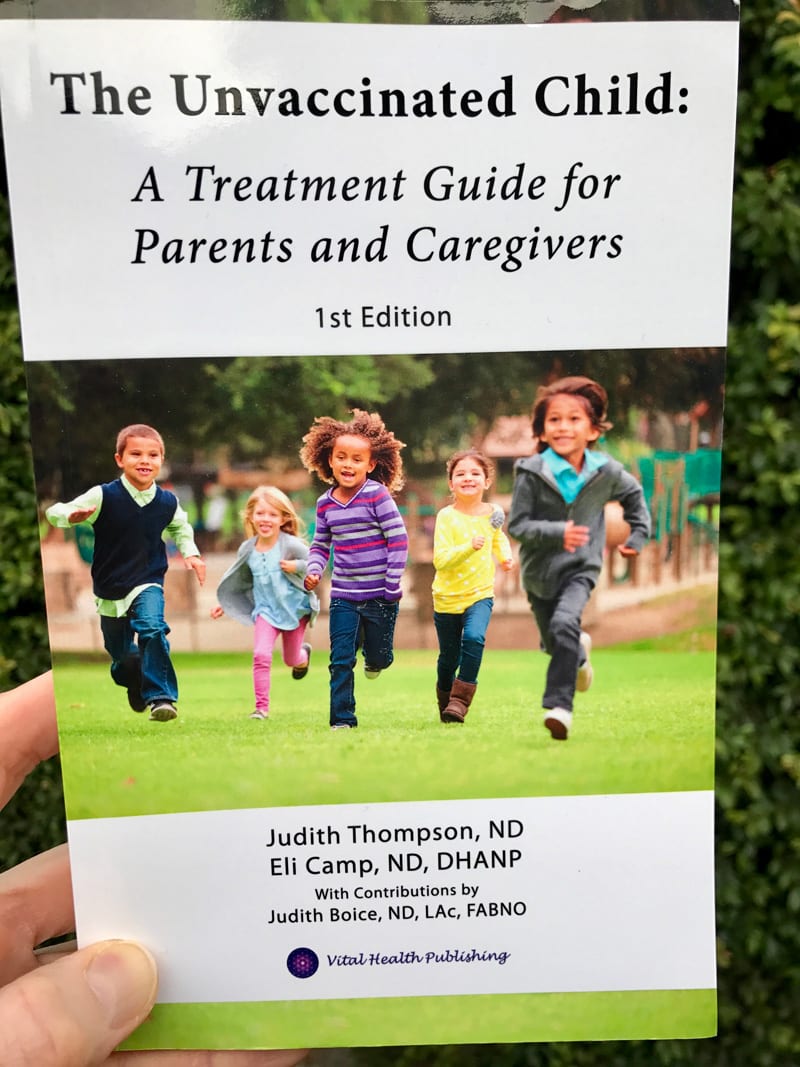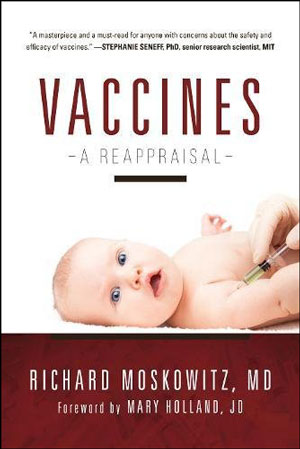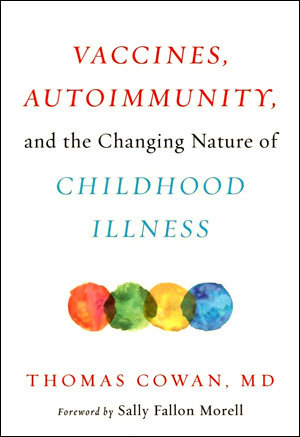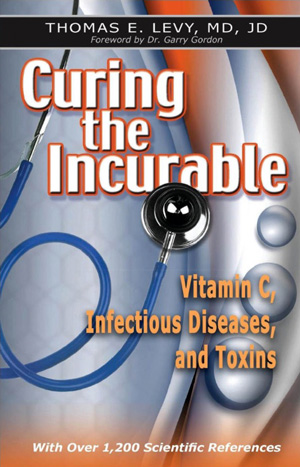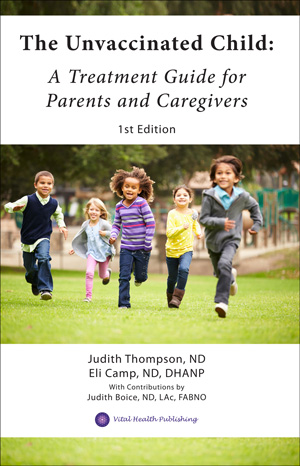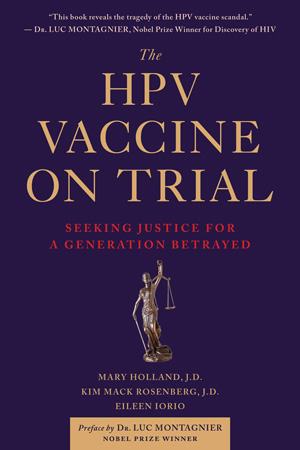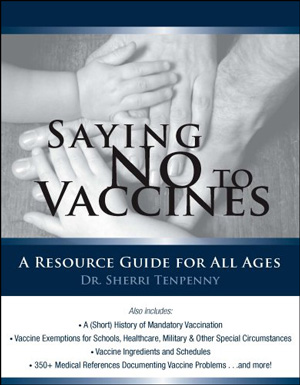The Need For Vitamin C
Vitamin C is the most powerful nutrient available that can literally cure the body of virtually any disease or condition, when the body has enough vitamin C in it! The key here is that the body must receive a HIGH DOSE of vitamin C in a short amount of time – depending on the condition and circumstance – in order to effectively resolve the situation / health challenge. Dr. Thomas E. Levy, MD was so impressed with the curative power of high dose vitamin C that he spent four years researching over 1,200 scientific references and then wrote a book about what he discovered: Curing the Incurable: Vitamin C, Infectious Disease and Toxins, 2011, Thomas Levy.
Dr. Levy cites examples of high dose vitamin C curing, preventing and/or effectively treating polio, diphtheria, whooping cough, tetanus, measles and all of the infections there are vaccines for. Dr. Levy also shares how high dose vitamin C cures venom bites (snake, spider, etc.), detoxes heavy metals (mercury, aluminum, lead, etc.) and other toxic substances (pesticides, plastics, smoke inhalation, carbon monoxide poisoning, etc.).
Dr. Levy says that liposomal vitamin C is the best type of C to take orally, and that combining oral vitamin C with intravenous vitamin C is the best course of action when faced with a severe health challenge. He recommends 6 to 12 grams of vitamin C per day for adults and I recommend that children be given vitamin C every day to help ensure there is also enough vitamin C in the body to withstand any infection or assault on the body. He states that if the body can get enough vitamin C into it quickly enough it can resolve virtually any health condition, even when comatose or near death! Lypo-Spheric Vitamin C by LivOn labs is a good brand and is very effective.
Naturopathic doctors and integrative medical doctors are trained how to administer intravenous vitamin C IVs to promote rapid healing of virtually any condition, and that includes recovery from any infection. One reason to have an alternative doctor at your disposal is to ensure that your child can get a vitamin C IV if warranted and that can only happen if you know who to call when you need to make it happen ASAP since hospitals and urgent care refuse to use this safe, highly effective nontoxic remedy. Going to an alternative health care practitioner to get a vitamin C IV for your sick child is far superior over going to the emergency room or urgent care!!!
NOTE: Vitamin C is unique in that you can take megadoses and it will not cause serious harm. However if you plan to stop taking it, you must wean off of large doses, gradually in order to prepare your immune system for the lack of incoming vitamin C. Other vitamins (like Vitamin A, which is fat soluble) are not the same. You can much more easily overdose on other vitamins and minerals and cause an imbalance.
Find An Alternative Doctor Now
If you do not yet have an alternative doctor on your team, especially one who can give vitamin C IVs, I would like to encourage you to actively search one out before the need arises. High dose vitamin C IVs are extremely effective for all infectious diseases and other ailments as well. Plus, alternative doctors are going to have more treatment methods than just antibiotics.
Vitamin A
Vitamin A is anti-viral and is an effective nutrient that will reduce mortality and morbidity of infections, including the measles. Try short-term high dose vitamin A when your child is ill with a virus (the WHO recommends one dose for two consecutive days). It’s important to note that there is only one study that accuses the measles virus of causing “immune amnesia.” They did NOT look at vitamin A levels. Measles virus depletes vitamin A, which is why it is so important to remain well-nourished and maintain adequate vitamin A levels in the body. Vitamin A plays a significant role in the development of immunological memory. “Immune amnesia” is very likely a vitamin A deficiency. Vitamin A is also important for mumps infections as well.
The Unvaccinated Child: A Treatment Guide for Parents and Caregivers
There are numerous highly effective natural remedies available to treat specific infections and Dr. Eli Camp, ND and Dr. Judith Thompson, ND have put together an excellent resource guide detailing those remedies and how to use them. In addition to giving your child high dose vitamin C and A, be sure to have this book on hand so you can review specific remedies for each infection listed below.
Infection Descriptions That There Are Vaccines For
Chickenpox (Varicella)
Chickenpox (varicella) is an illness caused by the varicella zoster virus, a DNA virus that is part of the herpes virus family and associated with shingles. The virus first presents as a chickenpox infection; however, if the virus reactivates, it will present as a shingles infection. Chickenpox is transmitted through direct contact with chickenpox blisters, by inhaling particles from the chickenpox blisters, and possibly from contact with respiratory secretions infected with the virus. Symptoms of chickenpox generally begin between 10 and 21 days following exposure to the virus and the illness typically lasts between 5 and 10 days. The varicella virus is found only in humans and outbreaks generally occur between March and May in the United States.
More: https://www.nvic.org/Vaccines-and-Diseases/Chickenpox.aspx
HIB (Haemophilus Influenzae type B)
Haemophilus influenzae (H. influenzae) is a small gram-negative coccobacillusfound only in humans and can be either encapsulated (typeable) or unencapsulated (nontypeable). H. influenzae type b (Hib) is transmitted by direct contact with respiratory secretions and enters the body through the upper respiratory tract. In most cases, Hib can remain in the mouth and nose for up to several months, without causing illness. In general, H. influenzae disease is considered to be minimally contagious, however, if a person has close contact to someone who is infected with or is carrying H. influenzae, transmission can occur.
More: https://www.nvic.org/Vaccines-and-Diseases/HIB.aspx
Diphtheria
Diphtheria is a rare respiratory disease caused by bacteria and the mucus membranes of the body. It begins with a gradual onset of a sore throat and low-grade fever and can involve the tonsils and nose.
Diphtheria causes a gray-green to black, thick fiber-like covering in the back of the throat. Neck swelling is usually present in severe cases. Diphtheria can lead to breathing problems, airway obstruction, paralysis, heart failure, coma and even death if not treated promptly.
Cutaneous (skin) diphtheria presents as skin lesions.
Diphtheria is an extremely rare disease in modern, developed countries with good sanitation. When outbreaks of diphtheria do occur, they almost always erupt in areas of poor sanitation and poverty.
Cases of diphtheria are so rare in both the US and other developed nations that, unless you are traveling to an impoverished country or a location of a natural disaster that has compromised the sanitation infrastructure, the danger of you or child getting diphtheria is very remote.
Diphtheria can reoccur in individuals who have already had the disease.
More: https://www.nvic.org/vaccines-and-diseases/Diphtheria.aspx
Flu / Influenza
Influenza is a viral infection that produces fever, chills, sore throat, muscle aches, and cough that lasts between a few days to 2 weeks. People tend to use the term “flu” to describe any kind of respiratory or gastrointestinal illness, such as colds or diarrhea and vomiting that resemble “influenza-like-illness” (ILI) symptoms. But influenza is usually associated with more severe illness and lasts longer than the common cold and, normally, influenza does not cause vomiting or diarrhea in adults.
The vast majority of people recover from influenza without any complications and develop immunity to future infection with the same strain or a related influenza strain that may prevent illness symptoms or make illness less severe.
More: https://www.nvic.org/Vaccines-and-Diseases/Influenza.aspx
Hepatitis A
Hepatitis A is viral disease of the liver caused by the hepatitis A virus (HAV). Humans are the only natural host of this virus.The hepatitis A virus is very stable and can remain present for several months in most environments. The virus, however, can be killed by high temperatures (temperatures greater than 85C/185F), or by solutions such as chlorine, or formalin. Hepatitis A is contracted orally and typically acquired by coming into contact with human fecal waste, generally through the consumption of contaminated food and/or water.Source of contamination may include raw shellfish, fruits and vegetables and ice.
An infected individual can spread hepatitis A to others for one to two weeks prior to becoming symptomatic. It generally takes an average of four weeks (range of two to seven weeks) following exposure to hepatitis A for symptoms to develop. Symptoms often occur suddenly and include fatigue, abdominal and/or joint pain, loss of appetite, fever, nausea, jaundice, dark urine, clay-colored bowel movements, and diarrhea. Young children are often asymptomatic and show no clinical signs of infection. Most infected individuals recover fully within 2 months, however, approximately 10 to 15 percent of infected individuals can have lingering symptoms for up to 6 months.
More: https://www.nvic.org/Vaccines-and-Diseases/Hepatitis-A.aspx
Hepatitis B
Hepatitis B (HBV) is a viral infection that infects the liver and requires direct contact with infected blood or other body fluids for transmission and most acute infections do not persist and become chronic.
Symptoms of hepatitis B generally appear in 90 days and last a few weeks, and about half of infected adults and children over the age of five will have symptoms, while many children under the age of five will not. Symptoms include fever, fatigue, loss of appetite, nausea, vomiting, abdominal pain, dark urine, discolored (clay) bowel movements, joint pain and jaundice (yellowish skin or eyes).
More: https://www.nvic.org/Vaccines-and-Diseases/Hepatitis-B.aspx
HPV
Human papillomaviruses are double-stranded DNA viruses found in the squamous epithelial cells on the surface of the skin and also the mucous membranes of the body. There are more than 200 known types of human papilloma viruses (HPVs) and most are not harmful. In the majority of cases, the human immune system clears HPV infections without symptoms or complications.
More than 90 percent of those who become infected naturally clear the infection from the body within two years.Antibodies to the HPV type causing the infection remain in the body to help prevent future infections but the protection may not be life-long.
More: https://www.nvic.org/Vaccines-and-Diseases/HPV.aspx
Measles
Measles (rubeola) is a highly contagious respiratory disease spread by coughing, sneezing, or simply being in close contact with an infected individual. The disease can be spread even when the rash is not visible. Measles tends to be more severe in children under 5 and adults over 20. Initial measles symptoms include fever, cough, runny nose, red irritated eyes, and sore throat with tiny white spots on the cheeks inside the mouth (Koplik spots). These symptoms generally last 2-4 days and are followed by the signature itchy red rash which appears on the body around the fourth or fifth day.
The majority of measles cases in the U.S. resolve without complication, though serious complications can occur. According to the Centers for Disease Control (CDC), Americans born before 1957 have naturally-acquired immunity to measles through past exposure to the illness. Infants born to mothers with naturally-acquired antibodies to measles benefit from passive maternal immunity. There is also evidence that mothers who have recovered from measles pass short-term measles immunity to their infants by breastfeeding.
More: https://www.nvic.org/vaccines-and-diseases/Measles.aspx
Meningococcal
Meningococcal disease is a bacterial illness caused by the aerobic, gram-negative bacteria Neisseria meningitidis (N. meningitidis). Thirteen types (serogroups) of N. Meningitis or meningococci have been identified with six found to be responsible for epidemics resulting in invasive meningococcal disease. Meningitis is the most common presentation of invasive meningococcal disease and accounts for approximately 75 percent of all cases.
Symptoms of meningitis begin to appear between 3 and 7 day after exposure to meningococcal bacteria. At first, symptoms may appear mild and similar to cold or flu symptoms and may include headache, fever, aches and pains. As the illness progresses, additional symptoms can include skin rash, severe headache, stiff neck, nausea, vomiting, inability to look at bright lights, mental confusions and irritability, extreme fatigue/sleepiness, convulsions and unconsciousness. In babies, symptoms can include a high-pitched moaning cry, difficulty or refusal to feed, and the fontanel, the soft area on the top of the head, may also be bulging.
More: https://www.nvic.org/Vaccines-and-Diseases/Meningitis.aspx
Mumps
Mumps virus is a contagious paramyxovirus that is comprised of a single-stranded RNA genome. Respiratory secretions transmit the virus and the infection begins in the nasopharynx and regional lymph nodes. After exposure, it generally takes 12 to 25 days for symptoms to develop. These symptoms typically include headache, muscle aches, tiredness, and loss of appetite. During this time, the virus is present in the blood and spreads throughout the body’s tissues. Parotitis, swelling of the parotid gland on one or both sides of the face under the ears and chin, is the most common clinical feature of a mumps infection, and typically occurs within the first two days. Up to 30 percent of people infected with mumps will have no symptoms of infection and up to 50 percent may exhibit signs of a mild nonspecific illness.
Mumps is generally a mild disease in childhood, but it can result in complications, though mostly in adults.Complications of mumps include inflammation of the testicles in males, inflammation of the breast tissue and ovaries in females, meningitis, encephalitis, and loss of hearing. Fertility problems following mumps infection are rare. Mumps rarely results in death and most people recover from mump infection within a few weeks.
More: https://www.nvic.org/vaccines-and-diseases/Mumps.aspx
Pertussis (Whooping Cough)
Pertussis, commonly referred to as whooping cough, is a highly contagious respiratory disease caused by the Bordetella (B.) pertussis bacterium. B. pertussis bacteria attach themselves to the mucus membranes of the respiratory tract and cause inflammation in the body.The major symptom of B. pertussis whooping cough disease is uncontrollable coughing.
Symptoms of B. pertussis at its onset are similar to the common cold, or an allergy attack with stuffy or runny nose, dry cough, loss of appetite, fatigue and, sometimes, a low fever. After one to two weeks, the disease usually progresses to bursts of spasmodic coughing (paroxysms) with large amounts of mucous, gagging and vomiting with or without a whoop that becomes worse at night.During the day, the child or adult may look and feel fine with the exception of frequent coughing spasms. A final recovery stage with only occasional coughing fits may last for weeks or even months.
More: https://www.nvic.org/Vaccines-and-Diseases/Whooping-Cough.aspx
Pneumococcal
Pneumococcal disease is an infection caused by Streptococcus pneumoniae (S. pneumoniae) bacteria. Only a few of the serotypes cause the majority of pneumococcal infections but nearly all serotypes have the ability to cause serious disease. S. pneumoniae are frequently found in the respiratory tract and up to 90 percent of healthy people may have the bacteria present in the nasopharynx (upper area of the throat behind the nose). Between 20 and 60 percent of all school children may also carry the bacteria.2
Most pneumococcal infections are mild, however, serious illness can occur. S. pneumoniae can cause several types of infections, including pneumonia, ear infections, sinus infections, bloodstream infections (bacteremia) and meningitis. Less commonly, S. pneumoniae can cause bacterial bone and joint infections, pericarditis, endocarditis, and peritonitis.
More: https://www.nvic.org/Vaccines-and-Diseases/Pneumococcal.aspx
Polio
- Poliomyelitis, commonly called polio, is an infection caused by a virus that multiplies in the gastrointestinal tract. There are three main serotypes of polio virus: PCV1, PCV2 and PCV3. Polio is transmitted when the virus enters the mouth or nose and infects the throat and gastrointestinal tract.
- In about 95% of cases, polio infection is subclinical and does not cause symptoms. In 4-5% of cases there may be minor symptoms, such as sore throat, low grade fever, headache, fatigue and nausea followed by stiff neck, meningitis (brain inflammation) and temporary paralysis of an arm or leg but there is full recovery within a few weeks. In less than 1% of cases, the polio virus infects the central nervous system and paralyzes the muscles of the arms and legs or muscles needed for breathing and swallowing, which can lead to permanent paralysis or death. Some adults, who appear to have fully recovered from polio as children, have developed post-polio syndrome (PPS) and experience weakness and pain in muscles and joints.
- The live attenuated oral polio vaccine (OPV) can cause vaccine strain polio in the vaccinated person or can cause vaccine strain polio in a person, who comes in contact with a recently vaccinated person’s body fluids (urine, stool, saliva) because the vaccine strain polio virus is shed for several weeks after vaccination. Vaccine strain polio can cause mild or severe and permanent paralysis similar to the paralysis caused by wild type polio.
- As of 1999, use of OPV was discontinued in the U.S. and replaced with inactivated, injectable polio vaccine, which cannot cause vaccine strain polio. However, OPV is used widely in annual polio vaccine campaigns targeting children in parts of Asia, Africa and the Middle East.
- Polio was declared eradicated in the U.S. in 1979 and eradicated in the western hemisphere in 1994. Today, globally it is an infectious disease that affects children living in poverty in socioeconomically disadvantaged areas, where sanitation and hygiene is poor and access to clean water and food is limited.
More: https://www.nvic.org/Vaccines-and-Diseases/Polio-SV40.aspx
Rubella
- Rubella is a mild viral infection that primarily occurs in childhood but can also affect adults. Known as the “German measles” or “three day measles,” rubella infection produces a rash that resembles a mild case of rubeola (measles);
- About 20% to 50% of rubella infections are asymptomatic. Rubella symptoms may begin with a mild fever, runny nose, sore throat, swollen lymph nodes and progress to a pink rash that starts on the face and spreads to the neck, arms, chest and sometimes the legs, disappearing as it moves downward on the body. The rash is not as red or blotchy as measles and generally fades by the third to fifth day;
- Rubella is a respiratory infection that is spread from person-to-person through coughing and sneezing. The virus can be found in an infected person’s throat and blood;
- Incubation period is from exposure to symptoms is 14 to 21 days. Recovery from rubella usually confers lifelong immunity, although there are rare reports of repeat cases;
- While rubella is mildly contagious and usually not a serious infection, a pregnant woman infected with rubella during the first three months of pregnancy has a 25% greater chance of suffering a miscarriage or giving birth to a baby with congenital rubella syndrome and birth defects. Infants born with congenital rubella syndrome can suffer from deafness, blindness, heart defects, developmental delay or mental retardation, small head size and other serious health problems;
- Young adults, especially young women, who are infected with rubella may have swollen glands in the back of the neck and joint pain, swelling and stiffness (arthritis) that lasts for several weeks. Rarely, more serious complications of rubella include brain inflammation and chronic arthritis;
- Between 2009 and 2013, there was an average of 6 cases of rubellareported in the U.S. annually.
- Rubella symptoms mimic the same as vitamin A overdose, so make sure you are not overdoing vitamin A-rich foods and supplements.
More: https://www.nvic.org/vaccines-and-diseases/Rubella.aspx
Rotavirus
- Rotavirus is the most common cause of severe diarrhea among children worldwide. There are five main strains that cause more than 90 percent of human rotavirus infections in developed countries, such as the U.S., but rotavirus strains are more diverse in developing countries.
- Rotavirus is very contagious; it spreads when infants or young children come into contact with an infected person’s body fluids or feces, or items that have come in contact with the feces of an infected person. Most cases of rotavirus occur in children ages 3 months to 35 months old.
- Rotavirus disease usually starts with upset stomach and vomiting, often with fever, followed by diarrhea. The watery diarrhea can be mild to severe and generally will last for 3 to 7 days. Severe diarrhea can lead to a dangerous depletion of body fluids called dehydration, which can result in death if untreated. Virtually all children become infected with rotavirus in the first 3 to 5 years of life, but severe diarrhea and dehydration occur mainly among children aged 3 to 35 months.
- The incubation period for rotavirus disease is approximately 2 days. Immunity after first infection is incomplete, but repeat infections tend to be less severe than the original infection. By age five, most healthy children do not exhibit symptoms of severe diarrhea when re-infected with rotavirus because each previous re-exposure to the disease has built a stronger immunity.
- According to the CDC in 1999, rotavirus was causing 20 to 40 infant deaths annually in the US when the first rotavirus vaccine, RotaShield, was introduced. It was estimated that about 50,000 hospitalizations occurred in the US because of severe diarrhea and dehydration.
- Today, even though almost all US infants receive vaccines for rotavirus, and despite efforts to improve the management of childhood rotavirus-associated diarrhea, hospitalizations of children in the U.S. with the disease have not significantly declined in the past two decades: the CDC says rotavirus infection is still responsible for an estimated 400,000 doctor visits; more than 200,000 emergency room visits; and 55,000 to 70,000 hospitalizations in the US.
More: https://www.nvic.org/Vaccines-and-Diseases/Rotavirus.aspx
Tetanus
Tetanus (lockjaw) disease is caused by Clostridium tetani (C. tetani), an anerobic, gram-positive, bacteria with the ability to develop into a spore. Tetanus spores can be found in soil, manure, and in the digestive tracts of animals and humans. Additionally, tetanus has also been reportedly found in contaminated heroin and on skin surfaces. Tetanus bacteria do not survive in the presence of oxygen; however, they are quite resistant to most chemicals and even heat. Puncture wounds, which do not bleed very much and are protected by tissue and skin from direct exposure to oxygen, can be the perfect environment for tetanus bacteria to multiply and cause infection.
The incubation period for tetanus infection, from time of exposure to appearance of the first symptoms, ranges from three days to three weeks. Initial symptoms include muscular stiffness of the jaw and neck, headache, seizures, changes in heart rate and blood pressure, fever, and chills. Complications include fractures, vocal cord spasms, impaired breathing, pulmonary embolism, pneumonia, infections acquired in the hospital during the course of treatment, and death.
More: https://www.nvic.org/Vaccines-and-Diseases/Tetanus.aspx
When to call your primary care doctor
You don’t always have to bring your child in to get some medical advice.
Calling the doctor’s office to speak with an on-call nurse is sometimes helpful.
When to go to urgent care or the ER
Always listen to your gut, your intuition. If you feel your child is struggling with any particular infection, if the remedies described previously are not helping to improve your child’s condition or your child is getting worse, do what you feel you must do to protect and care for your child.





